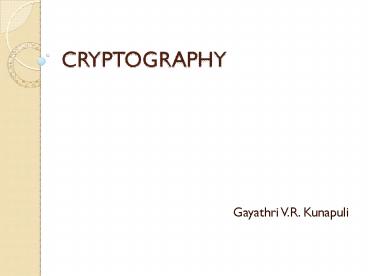CRYPTOGRAPHY - PowerPoint PPT Presentation
1 / 17
Title:
CRYPTOGRAPHY
Description:
Enigma Machine. Need for Cryptography[1] Authentication of the Communicating Principals ... Encryption algorithm E turns plain text message M into a cipher text ... – PowerPoint PPT presentation
Number of Views:43
Avg rating:3.0/5.0
Title: CRYPTOGRAPHY
1
CRYPTOGRAPHY
- Gayathri V.R. Kunapuli
2
OUTLINE
- History of Cryptography
- Need for cryptography
- Private Key Cryptosystems
- Public Key Cryptosystems
- Comparison between Public and Private Key
Cryptosystems - PEM
- Future Work
3
History of Cryptography2
- Ceaser Ciphers
- Transposition Cipher
- Substitution Cipher
- Vigenere Cipher
- Enigma Machine
4
Need for Cryptography1
- Authentication of the Communicating Principals
- Authenticated message carries a Digital Signature
5
Private Key Cryptosystems1,2
- Also called Symmetric Cryptography
- Encryption algorithm E turns plain text message M
into a cipher text C - CE(M)
- Decrypt C by using decryption algorithm D which
is an inverse function of E - MD(C)
6
Private Key Cryptosystems cont1,2
- Algorithm decomposed into Function(public) and
Key(secret) - Encrypted using the key Ke and decrypted using
the key Kd - MDKd(EKe(M))
- A function and a variable number of keys
constitute a class of algorithms indexed by the
keys.
7
Cont
- The encryption function is
- -One-to-one injective mapping
- -One way function
- The secrecy rests on the keys rather than on
algorithms. - The key should be of sufficient length in bits.
8
DES(Jan,1977)1,2
- Encryption consists of 3 stages of Transposition
and 16 stages of Substitution of bits. - Easy to implement on VLSI
- The 56-bit length key was found insufficient and
easy to break - Repetitions in cipher text give clues to
eavesdroppers - Spurious data can be injected
9
Contd
- Private Key systems require n(n-1)/2 keys for
n principals in a system - The conversation key must be agreed upon
beforehand - Management of the keys is a function of the Key
Distribution Server(KDS)
10
Public Key Cryptographic Systems(Need)1
- Also called as the Asymmetric Cryptography
- To avoid the need to transmit secret keys and
- To reduce the key requirement to 2n, the public
key systems are used
11
Public Key Cryptosystems Cont
- Introduced by Diffie and Hellman
- Each principal keeps a set of encryption keys (Ke
Kd) - Encryption algorithm E is public and so is the
key Ke - Decryption algorithm D and decryption key Kd is
kept private - Data sent to a principal is encrypted using that
corresponding Ke - E and D can be made public if Ke and Kd are
chosen such that it is impossible to infer Kd
from Ke.
12
RSA(Aug,1977)1,2,5
- The algorithms E and D are inverses
- Plain text messages are limited to a size is
limited to k - Integer k is chosen such that 2k lt N
- N p q where p q are LARGE prime numbers
- Kp (public encyrption key) and Ks (private
decryption key) are derived from p q
13
Contd
- The robustness of RSA algorithm relies on the
computational complexity in factoring a large
number upon which the keys are based. - The authenticity of the sender can also be
verified.
14
Comparison between the cryptosystems1
- Private Key DES is computationally efficient
- Public Key RSA is computationally expensive
- Possible best use is RSA for short/important data
and DES for long or less critical
15
PEM1,5
- Provides mechanism for the mail users to specify
the cryptographic algorithm and parameters to be
used for mail messages. - Essential data fields in PEM are
- DEK
- IK
- MIC
16
Extended Works4
- To prevent the Denial-of-Decryption
- To reduce the time taken for the authentication
of the digital signatures - Self Generated Certificate Public Key Cryptography
17
References
- 1. Chow, Randy Johnson, Theodore Distributed
Operating Systems Algorithms, 1998 - 2. Aiden A.Bruen,Mario A.Forcinito
Cryptography, Information theory and
Error-correction,2005 - 3.www.wikipedia.org/history of cryptography
- 4. Self generated certificate public key
cryptography and certificateless
signature/Encryption scheme in the standard model - ASIACCS07, March 20-22, 2007, Singapore.
- 5.http//www.cybercrimes.net/Cryptography/Articles
/Hebert.html (April 2007)































